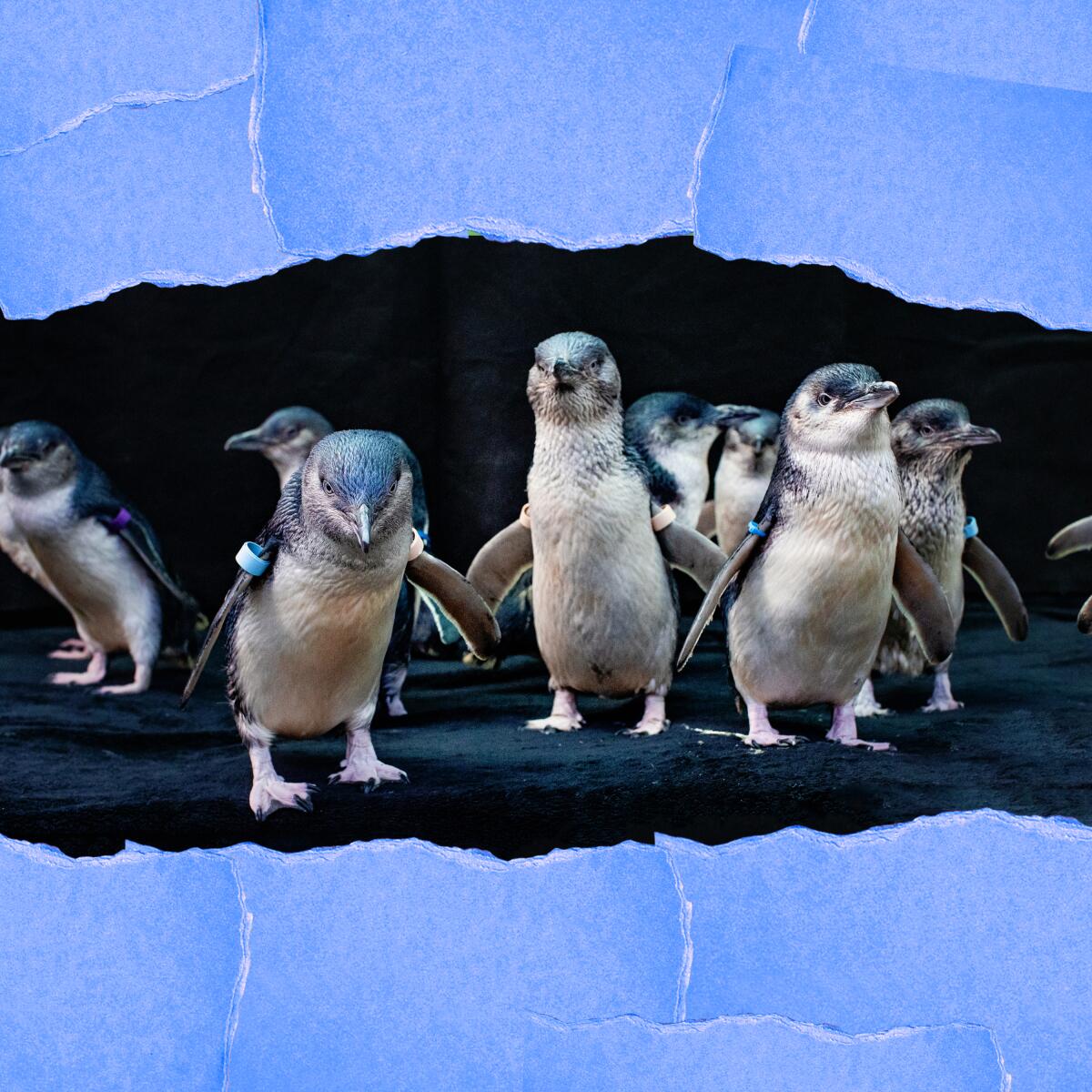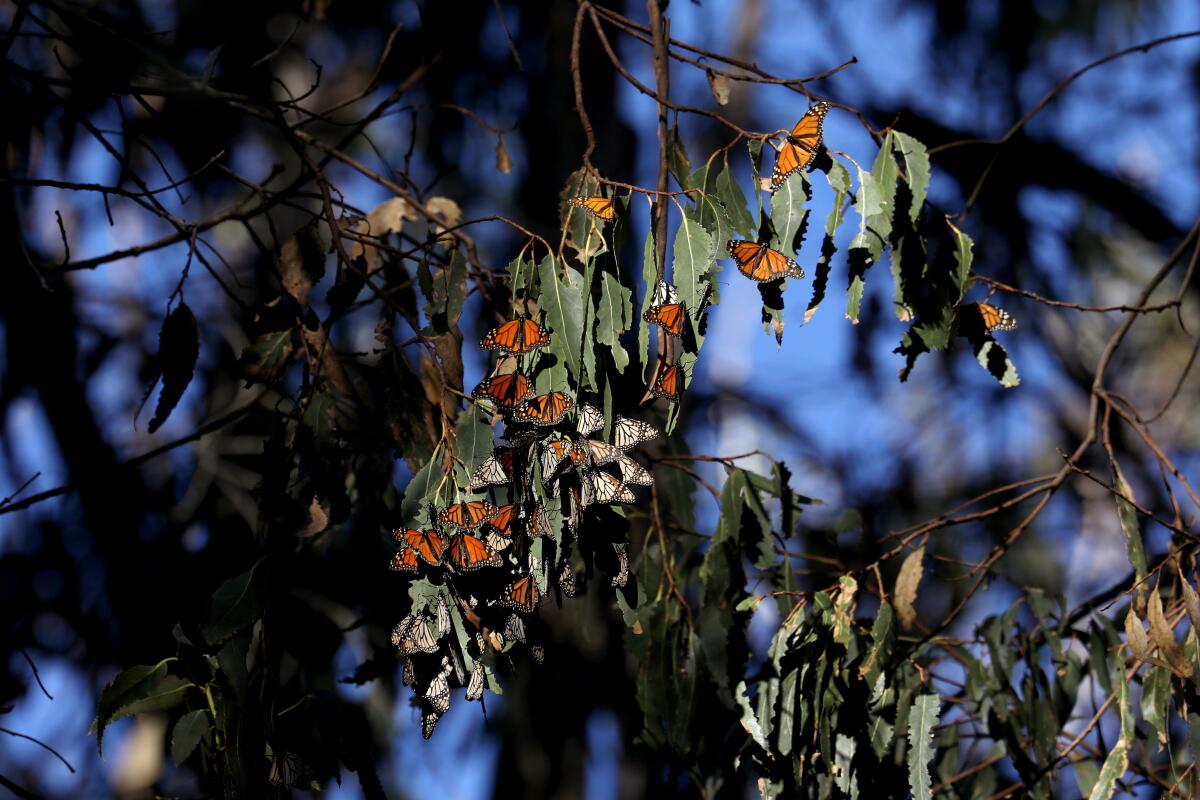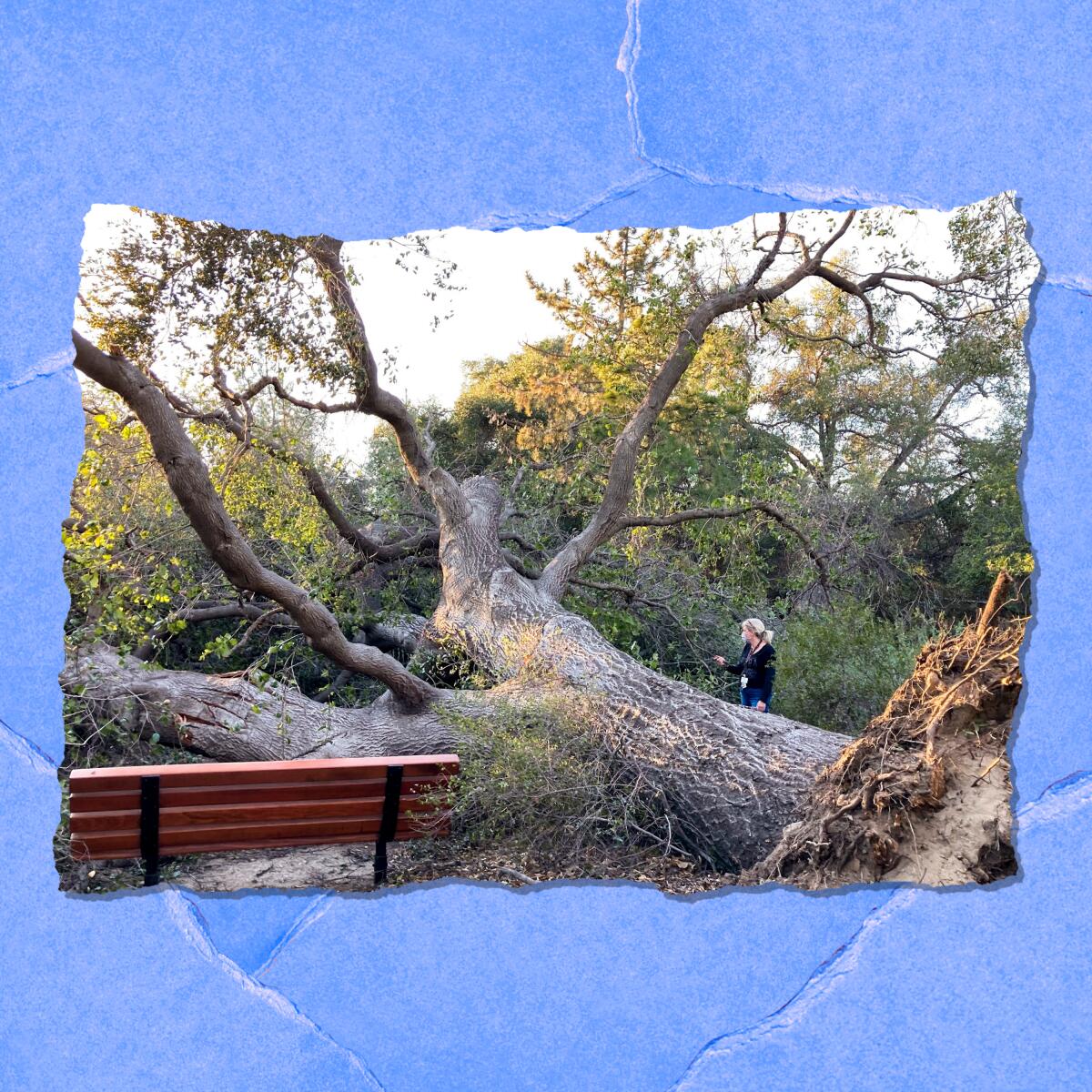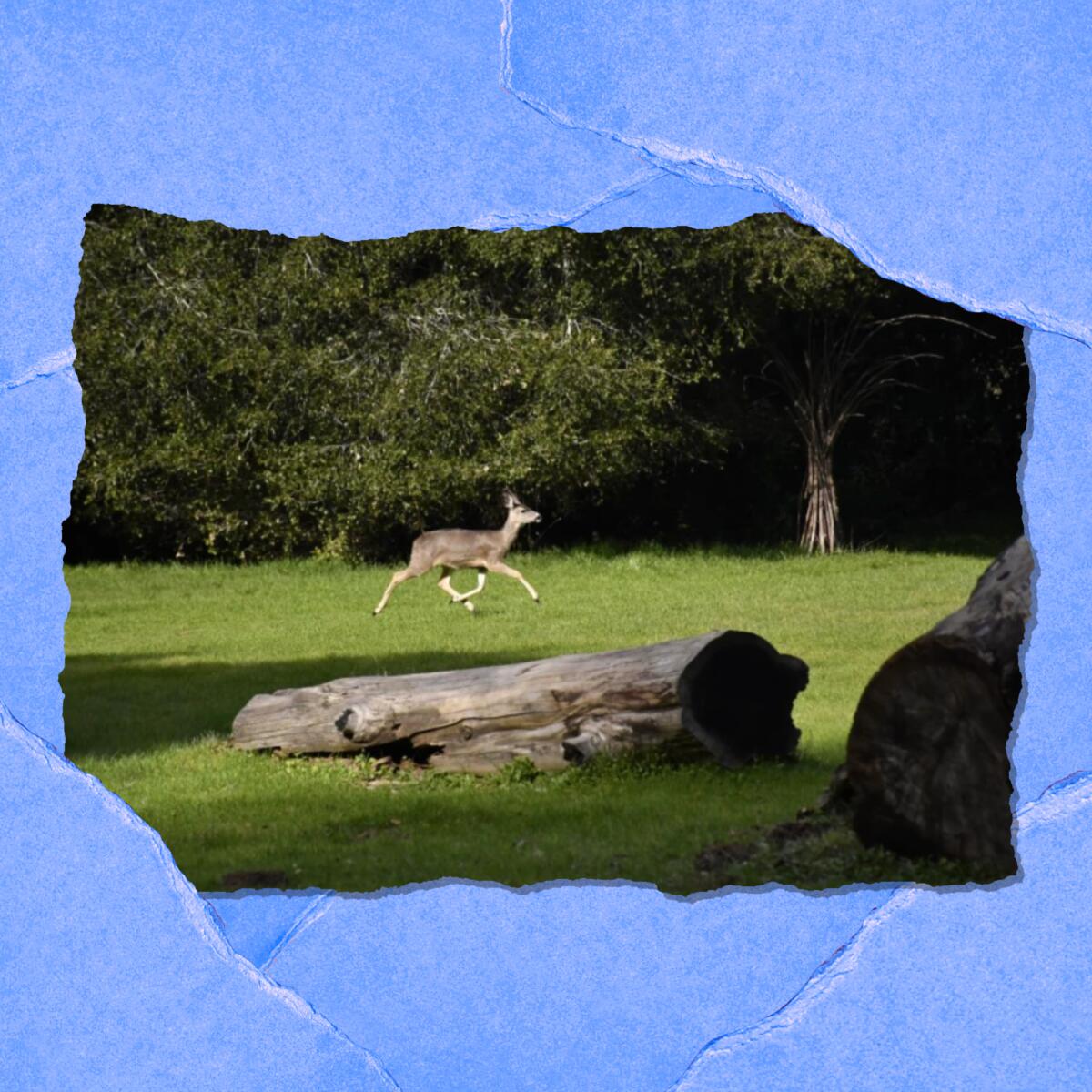These blooming trees make it feel like spring in L.A.

- Share via
By Mary Forgione
Design and illustrations by Micah Fluellen
Quick, check the calendar. Spring doesn’t start until March 20, but there’s a tree in the L.A. area that’s pushing that date to ... right now.
You can’t miss the fluffy white clusters that adorn the branches of these tall trees. Evergreen pear trees (Pyrus kawakamii) native to Asia are showering city streets with confetti-like white flowers that hardly scream February. I shared my wonder with Yvonne Savio, master gardener, garden consultant, blogger on GardeningInLA.net and Southern California Horticultural Society board member. Savio said the trees, which she finds in her Eagle Rock neighborhood along Colorado Boulevard east of Figueroa Street, are blooming early, likely because of recent warm weather. “Blossoms last a couple of weeks, from the first few to full-blown to the last gasp,” she wrote in an email.
There’s one other thing: The flowers stink.
Unlike sweet-smelling cherry or orange blossoms, evergreen pears carry an off-putting scent, apparently attractive to pollinating flies as well as bees, that “ranges from mildly unpleasant to downright awful to some people,” Savio wrote. The trees, which have distinctive textured bark, develop greenish brown fruits that are inedible (except maybe to birds) and lose their leaves in winter. Enjoy the early harbingers of spring that you’ll see a bit longer along sidewalks, in public gardens and parks, and maybe even in your neighbor’s frontyard.
3 things to do this week

1. Take a winter hike to a palm oasis in Anza-Borrego Desert State Park. The most popular hike in the north San Diego County state park undoubtedly is the 1.5-mile trail that leads to a stand of California fan palms, or Washingtonia filifera, the only native California palm trees. I was among a handful of people to make the trek early Saturday — and was surprised when the trail ended abruptly before entering the oasis. I wasn’t allowed (nor was anyone else) to walk farther. That’s because the trees were deliberately set on fire in 2020. Docents told me the palms and surrounding plants were a gray, smoking mess at the time. The canyon closed after the fire and again because of the COVID pandemic. Since then, the trees have bounced back, their tops bushy green, though their trunks are still charred. I recommend taking the well-marked main trail up the canyon, where you’ll boulder-hop amid flowing water, and return by way of the Alternate Trail, clearly marked, which takes you past ocotillo and cactus while offering wide views of the desert below. Go early; this canyon can get crowded later in the day. Find more information at the park’s website.

2. Go roller-skating at a Super Bowl pre-game event in Santa Monica. This has to be the strangest pre-Super Bowl mash-up ever: athletes and influencers, L.A. roller skaters and a pop-up barbershop. No matter, go for the free pre-game workout at the pop-up skating rink at 129 Santa Monica Blvd. (across from Ye Olde King’s Head pub). Sessions with a live DJ and photo booths will be open noon to 8 p.m. Friday and Saturday. You may rent skates or bring your own. The rink is sponsored by Gillette Labs, which explains the promise of celebrity barbers at the site. Register for skate time here.

3. February is National Bird-Feeding Month. Here’s how you can take part. In 1994, a Congress member from Illinois declared February as feed-the-birds month because it’s “one of the most difficult months in the United States for wild birds.” Undoubtedly he was referring to areas of the country with snowy winters. Still, I appreciate the sentiment. About 59 million Americans feed wild birds, according to the U.S. Fish and Wildlife Service, a pastime that allows people to relax and connect with nature. How do you get started at home? Bob Shanman, longtime birder and owner of Wild Birds Unlimited in Redondo Beach, offered tips in an email. First-timers should pick a location where “you can see and enjoy the birds, and where the birds can see and find your feeders.” You can hang your feeder from a tree or shepherd’s hook or put it on a post. Shanman recommends starting with a combination of a “hopper-style feeder, a tube feeder and, if you like hummingbirds, a nectar feeder.” The most important part is what feed you buy; many wild bird seed mixes contain “filler, with grains such as milo, corn, wheat and oats” — items birds won’t eat and leave in a heap below your feeder, Shanman wrote. “Providing high-fat foods such as peanuts, no melt suet, mealworms or a special blend during winter, with cold weather and long nights when natural food resources are scarce, is also important for the birds and gives us the opportunity to see even more types of birds,” he wrote. Once you get going, remember to keep your feeders clean and disease-free. The USFW offers tips on how to maintain feeders while protecting avian visitors in this Q&A titled “To Feed or Not to Feed Wild Birds.”
The nature of it all

Maybe it’s time to stop telling kids not to get dirty when they go outside. Isn’t that the point? New Jersey journalist Ambreen Ali writes in this L.A. Times Opinion piece about the anti-nature programming she experienced while growing up in California: “I recalled then how I had been discouraged as a child from getting dirty at the park. Or how the first thing we did when we came home from school was change our clothes. We lived in Northern California then, our first home after we moved from Pakistan when I was 5. We went to the beach often — yet it was never to play in the sand or swim in the ocean. Nature was to be admired from afar, with the car windshield in between. Those trips were about the drive, winding through the Santa Cruz Mountains until the road opened to the coast. We would wave at the sea lions from the boardwalk, watch the sunset and drive home.” Read about how she savors her newfound love of nature.
Wild things

About a decade ago, I visited New Zealand and became acquainted with a species I had never seen before: little blue penguins. The smallest species in the penguin family indeed have gray-blue backs and white undersides. The birds, native to New Zealand and Australia, top out at 15 inches tall and weigh 2 or 3 pounds. They are noisy, squawky and adorable (OK, that’s my opinion). Ten little blues will be on display at UC San Diego’s Birch Aquarium in La Jolla in a custom-made habitat set to open July 1. Before then, if you have a cool $50,000, you may name one. The money will go to help fund the new habitat. More details here.
The must-read

I can’t stop thinking about the remarkable rebound of the Western monarch butterflies that spend the winter in California. Times staff writer Diana Marcum writes in this update: “The Xerces Society for Invertebrate Conservation announced in late January that community scientists had reported 247,000 overwintering butterflies in the 2021 Western Monarch Thanksgiving Count. There were fewer than 2,000 the year before. The data made clear what many had been noting since October: The monarchs are back, even if it’s far from the millions that arrived as recently as the ’80s.” The butterflies disappear in early March. If you don’t want to miss seeing them, head to these places in Central California: the Pismo Beach Monarch Butterfly Grove, the Santa Cruz butterfly preserve at Natural Bridges State Beach and the Pacific Grove Monarch Sanctuary.
The red flag

Recent strong winds blew down about 70 trees at the California Botanic Garden in Claremont. The garden has been closed since Jan. 22 until work to clear paths and trails can be finished. The power outage that accompanied the windstorms also threatened to destroy the “frozen seeds — embryos for the thousands of rare plants in the seed bank of the state’s largest botanic garden dedicated to native plants,” Times staff writer Jeanette Marantos reported. One of the biggest losses? A rare island live oak, a tree that usually grows only in the Channel Islands and parts of Santa Barbara County. Executive director Lucinda McDade said of the damage: “It looked like it snowed 6 inches of leaves, branches and sticks on all the trails.” Now the garden is looking at a $100,000 clean-up tab. Learn more about the fallen trees and how you can help.
P.S.

If you’re planning on scaling Mt. Whitney in the eastern Sierra or Half Dome in Yosemite National Park this summer, your preparation starts now. Applications for the permit lottery to day-hike or overnight on 14,505-foot Mt. Whitney is on now through March 15. If you prevail in the lottery, it costs $15 per person plus handling fees. This Inyo National Forest web page tells you everything you need to know about how to get permits, even if you don’t succeed in the lottery. Also, you may enter the pre-season lottery March 1 to 31 for permits to hike up Half Dome. These permits allow you to use the cables, installed in summer, for the steepest bit of the ascent to the 8,839-foot summit. Again, this isn’t the only way to get Half Dome permits; there’s also a daily lottery in May through mid-October. Read about Half Dome permits at Recreation.gov.

Read why a Northern California town, where the median home value is $4.5 million, has declared itself a mountain lion habitat. Hint: It may be less about protecting lions and more about dodging a state affordable housing law, according to Rob Bonta, California’s attorney general.
Need more politics-tracking news? Sign up for L.A. on the Record, an upcoming newsletter about L.A. politics written by the L.A. Times City Hall team, a mix of transplants and native Angelenos who are experts in the subjects that matter. It’s free too.
Enjoying this newsletter? Consider subscribing to the Los Angeles Times
Your support helps us deliver the news that matters most. Become a subscriber.
Send us your thoughts
Share anything that’s on your mind. The Wild is written for you and delivered to your inbox for free. Drop us a line at TheWild@latimes.com.
Click to view the web version of this newsletter and share it with others, and sign up to have it sent weekly to your inbox. I’m Mary Forgione, and I write The Wild. I’ve been exploring trails and open spaces in Southern California for four decades.

Sign up for The Wild
We’ll help you find the best places to hike, bike and run, as well as the perfect silent spots for meditation and yoga.
You may occasionally receive promotional content from the Los Angeles Times.




